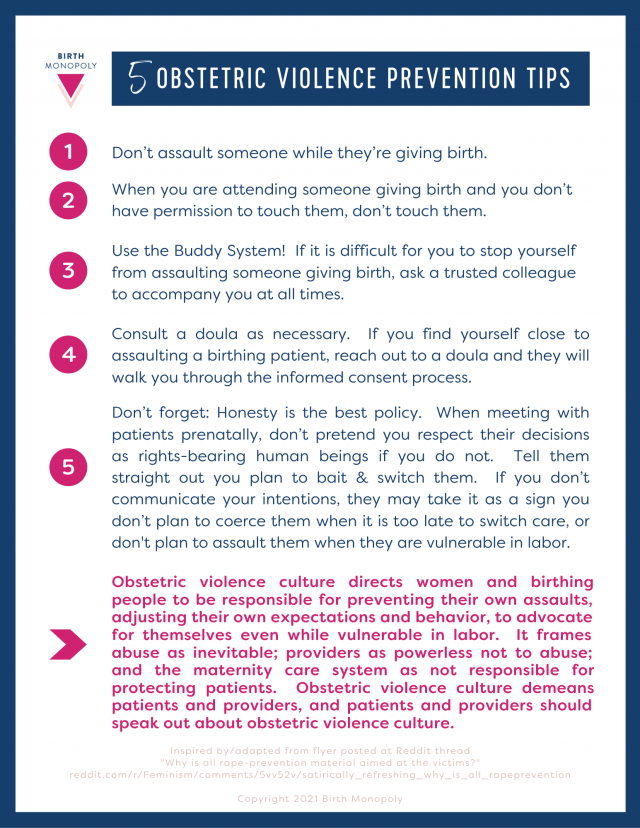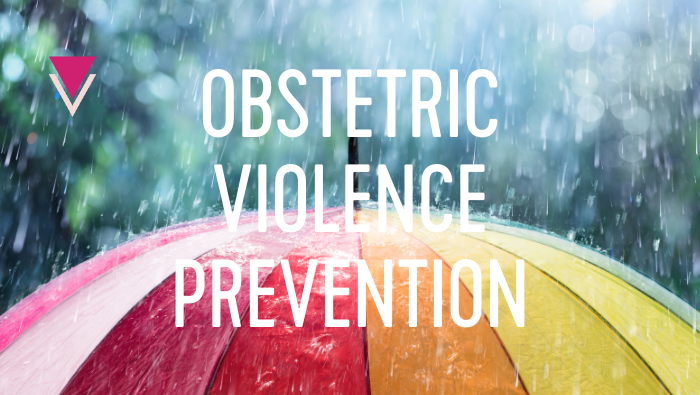5 Obstetric Violence Prevention Tips:
1. Don’t assault someone while they’re giving birth.
2. When you are attending someone giving birth and you don’t have permission to touch them, don’t touch them.
3. Use the Buddy System! If it is difficult for you to stop yourself from assaulting someone giving birth, ask a trusted colleague to accompany you at all times.
4. Consult a doula as necessary. If you find yourself close to assaulting a birthing patient, reach out to a doula and they will walk you through the informed consent process.
5. Don’t forget: Honesty is the best policy. When meeting with patients prenatally, don’t pretend you respect their decisions as rights-bearing human beings if you do not. Tell them straight out you plan to bait & switch them. If you don’t communicate your intentions, they may take it as a sign you don’t plan to coerce them when it is too late to switch care, or don’t plan to assault them when they are vulnerable in labor.
>> Obstetric violence culture directs women and birthing people to be responsible for preventing their own assaults, adjusting their own expectations and behavior, to advocate for themselves even while vulnerable in labor. It frames abuse as inevitable; providers as powerless not to abuse; and the maternity care system as not responsible for protecting patients. Obstetric violence culture demeans patients and providers, and patients and providers should speak out about obstetric violence culture.

Share this image from Facebook or Instagram
I love that awareness about obstetric violence is getting out there more and more, and people are increasingly proactive about finding safe and respectful maternity care.
But every once in a while, I see someone share their own story of surviving obstetric violence and responses pop up like:
“That’s why I hired a doula!”
“You should research your hospital and provider better.”
“Just stay home next time–get a midwife.”
“I would have told that nurse to get out of my room!”
Writer, birth advocate, and obstetric violence survivor Zawn Villines says this kind of thing is “victim-blaming wrapped up as birth advocacy.”
Much like other victims of abuse do, victims of obstetric violence may find themselves receiving advice about how they could have prevented or responded to their own abuse. Often, this advice is way after the fact and delivered in a way that is dismissive of the trauma they experienced. The truth is, no one can really say how they would respond when their trauma response kicks in–especially in the ultra-vulnerable position of being in labor.
And all the research and the best doula in the world can’t prevent true medical emergencies or change the call schedule when an abusive provider (obstetrician or midwife) is the only one available.
Sometimes, I get really frustrated at all the efforts (including my own!) directed at and by birthing people and their support teams to avoid obstetric violence… while it’s crickets from professional organizations and institutions that need to be training and disciplining their folks to not commit obstetric violence.
Even the many helpful articles out there for parents usually avoid labeling behaviors like coercion and manipulation as abusive, or an epidemic of over-intervention as physically and psychologically harmful. They will optimistically frame the issue as “finding a provider who is a good fit for you,” avoiding any critical analysis of the practices of “bad fit” providers.
Sure, a good fit is crucial–but that’s not really what we are talking about here. An abusive provider is a bad fit for everyone, and no patient should ever have to calculate “level of abusiveness” in deciding who to see for care. No level of abuse is acceptable.
The bigger problem is our reflex to focus on what the victim, rather than the abuser, could or should have done differently.
This is rape culture.
Obstetric violence culture is rape culture
Likewise, obstetric violence culture frames abuse as inevitable, with patients bearing the responsibility to avoid it. It portrays providers as having either no ability or no duty to not abuse, and that lack of agency is reinforced when there is no mechanism in place to hold them accountable.
This culture makes “respect” and “consent” seem like bonus options or luxuries, possible in certain conditions with certain people, rather than baseline expectations for everyone.
The parallels do not end there.
Obstetric violence is an abuse of power around sexual organs and reproductive processes, whether by coercion, manipulation, or force. Certainly, not all obstetric violence is experienced as sexual violence, but a good amount of it involves non-consent around vaginas. It ends in damaged bodies, breakdown of trust, and changed life trajectories around sex and pregnancy. That is especially true for anyone with pre-existing trauma around consent and their bodies–which is most of us.

More about obstetric violence culture
With that in mind, I’m sharing these satirical tips on preventing obstetric violence. This list is based on the viral “Why is all rape prevention material aimed at the victims?” flyer posted on Reddit a few years back (link).
I remember when I first saw that flyer and how it hit me. As a little girl and later as a sexual assault survivor, I’d internalized blame and shame my whole life around how others have treated my body and did or did not respect my consent. It was liberating to see this perspective.
Satire like this can’t explore the complexities of why abuse happens in obstetric settings, how providers may be abused themselves, and the larger structures that allow it, and it’s not meant to. The purpose is to give you that jolt I remember getting when I first saw the original flyer about rape–to remind you of how different things might look if the onus to stop obstetric violence were on someone other than the people with the least perceived power in the room.
If you’ve experienced abuse, it’s because someone had the power to abuse you and they did, not because you didn’t work hard enough to avoid them. That shame doesn’t belong to you.
More:
Doulas and Advocacy
Know Your Rights: Legal and Human Rights in Childbirth for Birth Professionals and Advocates
Obstetric Violence Stories Map
So how can we better support and advocate in the birth arena, and not participate in victim blaming? Let’s call obstetric violence and rights violations by name; let’s be transparent about the real limits and amazing possibilities of advocacy in individual birth settings; and let’s embrace survivors of unnecessary birth trauma as whole people who need compassion first and foremost.
The eradication of obstetric violence is not something its victims can effect on their own. Providers and the entities that enable them must actively choose accountability and change, in processes that are patient led and trauma informed.
The very first step is recognizing that there is a name for coercion, manipulation, and force in the childbirth setting. It is obstetric violence, and its victims have borne the burden to solve the problem long enough.


Great article!! I was just thinking in the past couple days how obstetric violence is a direct reflection of the rape culture we live in. There needs to be a drastic shift in perspective!
Thank you for this article. Victim blaming is something I see happen time and time again and I’ve been doing what I can as a doula to chip away at it. I’m so tired of birthing people carrying the blame and shame of what happened to them in the birth room. This resource will give me one more way to try and change this sort of mentality and interrupt obstetric violence wherever I can.
Wonderful article. It is very difficult, especially for a first time mother, to respond properly at underhanded violence tactics.
As a doula, I witnessed this. I spoke up but I find myself traumatised- feeling like I should have done more…. What more can you say. You are gonna give her anaesthetic before you cut her..I said… response.. im not sure if there’s time. I repeated it. You will give her anaesthetic right.. and she hastily drew up an injection.. and gave it before immediately after started cutting. I felt the pain as if she were cutting me… and a little more of me died inside.
Great website- the obstetrics violence issues are a crisis world wide- vulnerable women in labour are mistreated appallingly and our society finds this unpalatable to hear so they ignore it. I am a psychologist and can see the unbelievably damaging implications of this terrifying abuse – it has to stop it just has to be stopped.